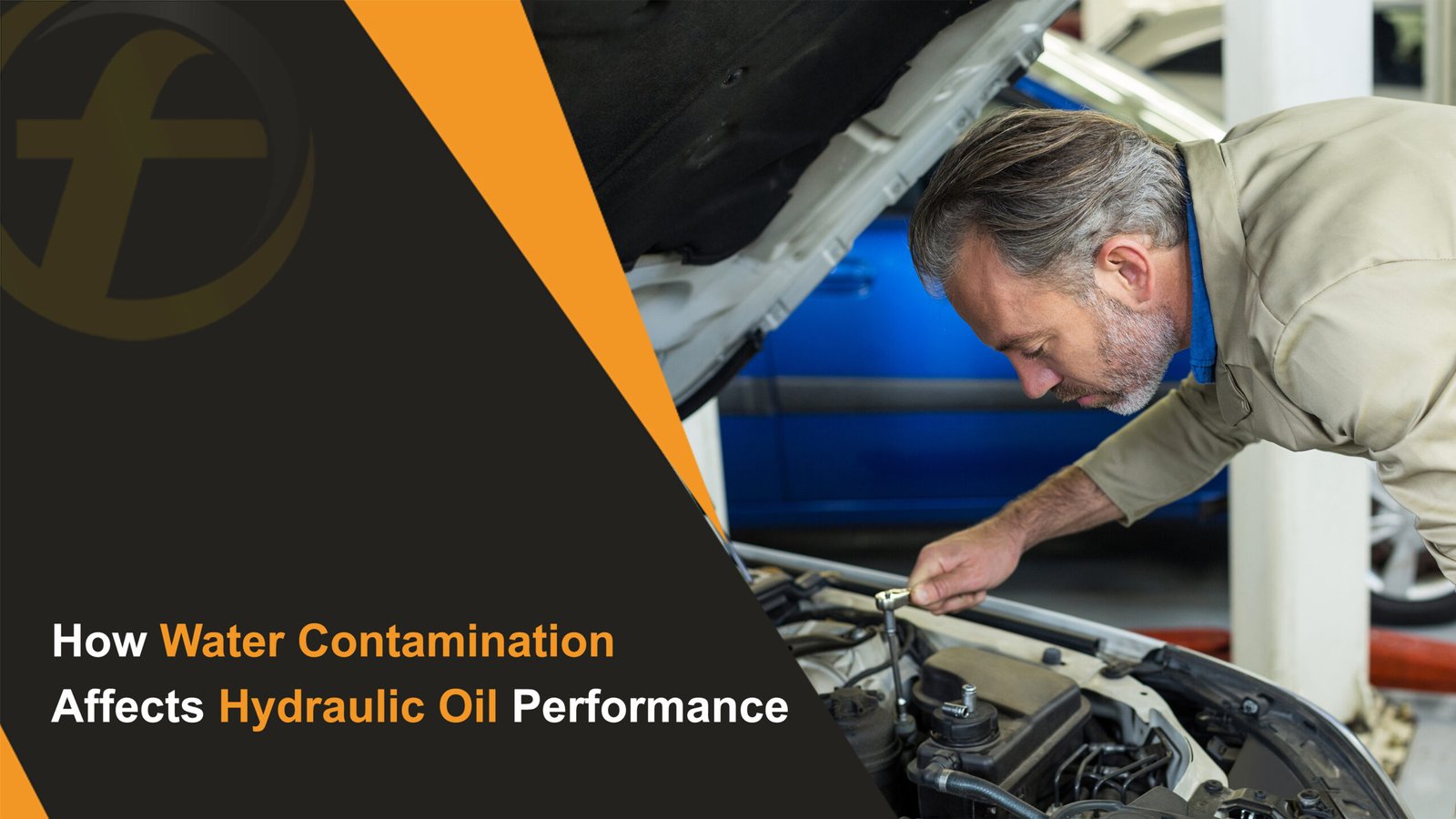
Hydraulic systems need clean oil to work their best, but water is one of the most common and damaging contaminants. Even in well-maintained machines, water can sneak in through leaks, condensation, or the environment.
At Fubex Lubricants, we offer high-quality hydraulic oil for all types of engines. Enjoy fast shipping, a price match guarantee, and no-questions-asked returns. Need help choosing the right oil? Call us at +971 50 544 9614 — our friendly team is ready to assist!
Once inside, it can weaken the oil, reduce performance, and cause serious damage to system parts. Understanding how water enters the system, the problems it creates, and the steps you can take to prevent it is the key to keeping your hydraulic equipment reliable, efficient, and long-lasting.
Sources of Water Contamination
Even in the best conditions, it’s almost impossible to keep water out of a hydraulic system. Water can get in from the outside, like rain, routine cleaning, leaky seals, or cylinders. It can also come from inside the system, such as condensation or heat exchangers. For example, when a machine works in a hot and humid place, it pulls in air with water vapor. As the air cools down, the vapor turns into water and stays in the system.
Water can show up in three forms: dissolved, mixed (emulsified), or free water. When the fluid cannot hold any more dissolved water, it reaches a point called saturation. The saturation point depends on the type of oil, the additives in it, and working conditions like pressure and temperature.
Types of Hydraulic Fluid Contamination
Hydraulic systems can get dirty in different ways, and this can hurt how well they work and how long they last. Here are the main types of contamination:
- Solid Particles: These include dirt, dust, rust, tiny metal pieces, or even welding leftovers. They can scratch and wear out important parts like seals, valves, pumps, and cylinders.
- Liquid Contaminants: Water is the most common liquid contaminant. It can get in through leaks or condensation. Sometimes other liquids, like coolant, may also enter by mistake.
- Air Contamination: Air bubbles inside the hydraulic oil can cause pressure changes and make lubrication less effective.
- Chemical Contamination: Chemicals can react with air or water inside the system, causing the oil to break down. Harmful substances like acids or corrosive fluids can also get in from poor maintenance or spills.
- Microbial Growth: If water and organic material are present, bacteria or fungi can grow in the oil. This can clog filters and damage sensitive parts of the system.
How Contaminants Get into Hydraulic Systems
Contaminants can enter a hydraulic system in many ways. Knowing where they come from helps keep the system clean and safe.
- Breather Caps: Hydraulic tanks often have breather caps with filters to let air in and out. If the filter is damaged or clogged, dirt and dust can slip inside.
- Fluid Handling and Filling: If dirty tools, containers, or poor filters are used while adding or moving fluid, dirt and debris can get into the system.
- Worn-Out Parts: When seals, hoses, O-rings, or valves wear out, they can break down and create tiny particles that contaminate the fluid.
- External Contamination: Dust, dirt, or debris from the environment can enter open reservoirs during checks or maintenance if lids are removed.
- Poor Maintenance: Not keeping things clean while changing filters or replacing parts can accidentally add contaminants.
- Reused Containers: Using dirty containers for new fluids can transfer leftover contaminants from the old fluids.
- Water or Moisture: Moisture can enter through condensation, leaks, wet environments, or cooling systems, which can mix water with the hydraulic fluid.
Problems Caused by Water Contamination
Water in a hydraulic system can cause many problems. Sometimes you may see cloudy fluid, which is a sign of too much water. But often, you can’t notice it until damage starts happening. Here are some common problems water can cause:
- Corrosion: Water can cause metal parts to rust and weaken.
- Oxidation: Oxygen in the water can react with the fluid, breaking it down and making it wear out faster.
- Thinner Fluid: Water lowers the oil’s thickness (viscosity), making it less slippery, less strong, and less able to carry loads.
- Bearing Damage: In bearings, water can turn into hot steam. This can cause tiny explosions inside the oil and crack the bearing surfaces.
- Hydrolysis: When water and heat mix, they can break down certain fluids. This makes acids that corrode and damage system parts.
- Crystallization: At very low temperatures, water can freeze into ice crystals that block the system.
- Higher Temperatures: Too much water makes the system work harder, which raises the temperature and slows performance.
- Cavitation: Water can create vapor pockets in the oil, making the fluid less effective and shortening its life.
- Foaming: Excess foam makes the system respond slowly and can also cause cavitation.
- Additive Loss: Water can reduce or destroy the helpful additives in hydraulic fluid, making it weaker.
- Sludge Formation: Water mixes with dirt, soot, or other particles to create sludge. This can clog filters and block oil flow.
Best Practices to Prevent Water-Related System Failures
Water can damage hydraulic systems, but with good care, you can avoid costly breakdowns. Here are some simple practices to follow:
- Check Fluid Levels: Look at fluid levels at least twice a year to make sure they are correct.
- Test the Oil Regularly: Set up an oil analysis program. This helps you measure how much water is in the fluid and check important things like acidity, thickness (viscosity), and slipperiness (lubricity). Regular testing lets you fix problems before they cause failure.
- Change Fluids on Time: All fluids wear out over time. Use test results to know the best time to change them. Always replace the filter when you change the oil.
- Fix Leaks Quickly: Even a slow leak should never be ignored, as it can lead to bigger problems.
- Follow Manufacturer Guidelines: Always follow the maintenance and warranty instructions from the equipment maker. Skipping steps to save time or money usually costs more later.
What is Hydraulic Fluid Contamination?
Hydraulic fluid contamination happens when unwanted substances get into the fluid. This can damage the hydraulic system, hurt its performance, and shorten its life. Contamination can happen in different ways, and each type causes its own problems.
Solving Contamination Problems
To keep hydraulic systems running smoothly, it’s important to deal with different types of contamination. Here are some simple solutions:
Built-in Contaminants
- Flushing: Before starting a new system or adding new parts, flush the system to clear out built-in dirt.
- Filtration: Use strong filters to trap leftover contaminants and stop them from moving around in the fluid.
- Clean Components: Always use parts from trusted makers that follow strict cleanliness rules.
Generated Contaminants
- Regular Maintenance: Stick to a maintenance schedule to catch problems from worn parts early.
- Right Fluid Choice: Pick the correct hydraulic fluid with the right thickness and additives to reduce wear.
- Component Checks: Look over parts regularly for wear or damage and replace them when needed.
Air Contamination
- Sealing: Seal the system tightly with strong gaskets and seals to keep air from leaking in.
- Better Design: Design systems to reduce bubbles (aeration) and cavitation that let air into the fluid.
Water Contamination
- Safe Storage: Keep hydraulic fluid in sealed containers in a clean, dry place to block moisture.
- Desiccant Breathers: Add special breathers on reservoirs to remove water vapor from incoming air.
- Fluid Testing: Test the fluid regularly to spot water early and fix the problem before damage happens.
Preventing Contamination of Hydraulic Fluid
Keeping hydraulic fluid clean is very important for the system to last longer and work well. By taking the right steps, you can stop damage before it happens and keep the system running smoothly.
Key Prevention Tips:
- Do regular maintenance checks to catch problems early.
- Use the right grade of hydraulic fluid for good temperature control.
- Design the system so it can cool properly.
- Install strong filters to trap dirt and other contaminants.
- Keep seals and gaskets in good shape to block leaks.
- Always use clean tools and methods during maintenance.
- Use water-resistant hydraulic fluids to keep water out.
- Add breathers or desiccant filters to fight water contamination.
- Fill fluids carefully to avoid trapping air.
- Use air eliminators to reduce air bubbles.
- Check the system often for leaks and fix them fast.
- Use high-quality seals and connections to stop fluid from escaping.
Preventing Overheating of Hydraulic Oil
Too much heat is dangerous for hydraulic systems. If the oil overheats, it can get thinner, lose its ability to lubricate, and damage parts. Experts recommend keeping oil below 60°C to protect the system.
Tips to Avoid Overheating:
- Choose hydraulic fluid with the right thickness (viscosity) for the temperature range.
- Design the system to release heat efficiently.
- Make sure the pump and reservoir keep fluid moving properly.
- Use coolers or heat exchangers to control temperature.
Closing Lines
In hydraulic systems, keeping fluids clean is very important. Knowing how contamination happens and what damage it can cause helps protect the system. By using strong filters, following good maintenance practices, and preventing problems early, hydraulic systems can run smoothly, last longer, and work with better reliability and efficiency.
FAQs
Q1: What is hydraulic fluid contamination?
Hydraulic fluid contamination happens when dirt, water, air, or leaks get into the fluid. This makes the system work poorly and can cause damage.
Q2: How does contamination affect hydraulic systems?
Contamination can cause overheating, wear on parts, poor lubrication, and lower efficiency. This reduces the system’s reliability and shortens its life.
Q3: What can be done to prevent contamination?
You can prevent contamination by using the right fluid, designing the system for good cooling, doing regular maintenance, and using strong filters to keep fluids clean.

Editor-at-Large
A passionate writer in the lubricant industry, Awais Iqbal has been covering oils, greases, and industrial fluids since the start of his career. At 25, he’s already written for blogs, catalogs, and brand guides across the UAE. Awais’s insights help companies connect with their audience, and his clear, helpful writing style is trusted by brands in the region.


